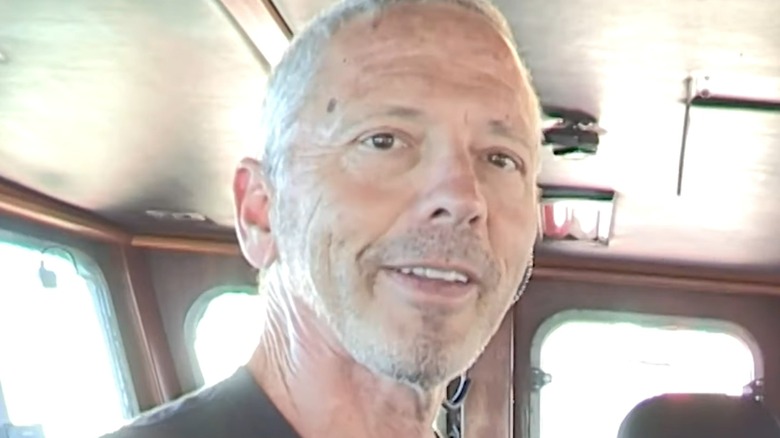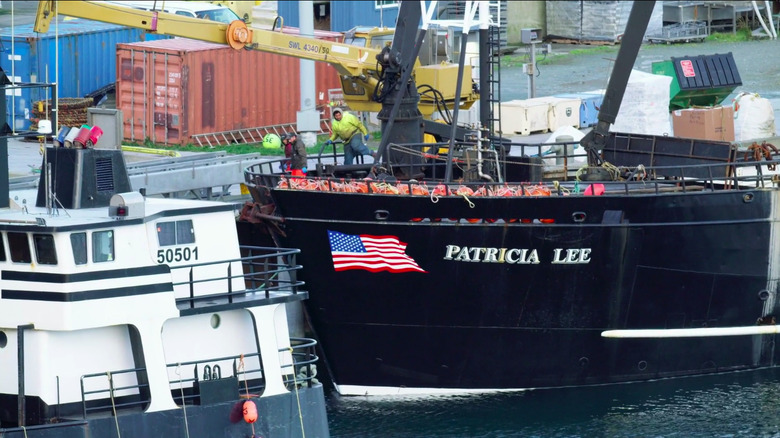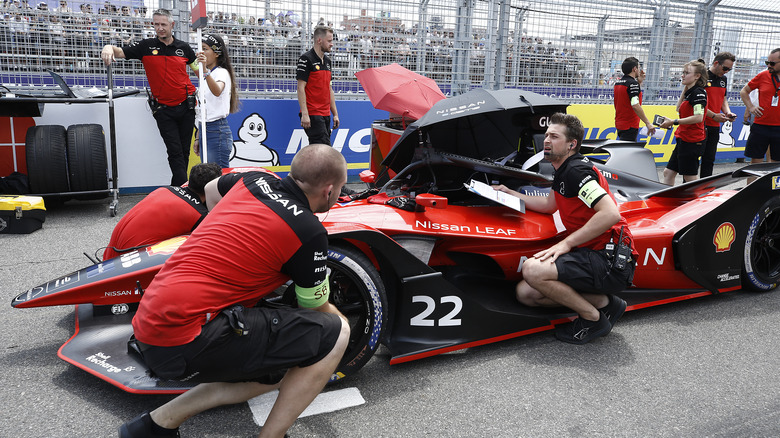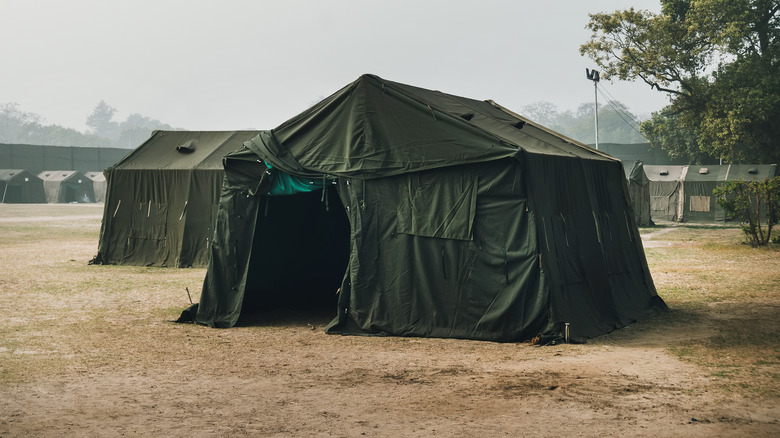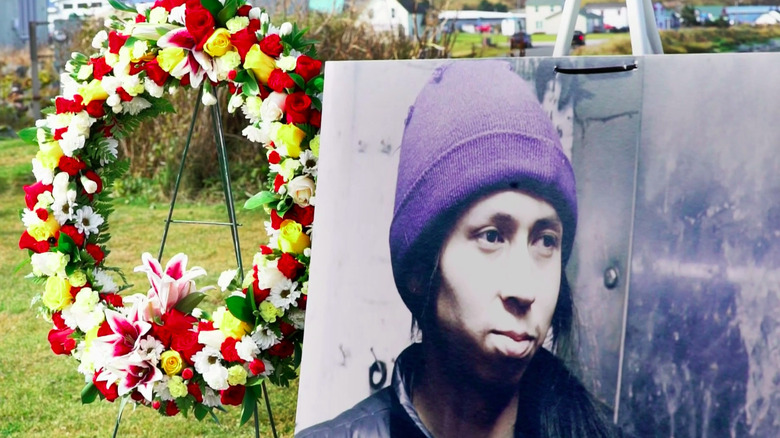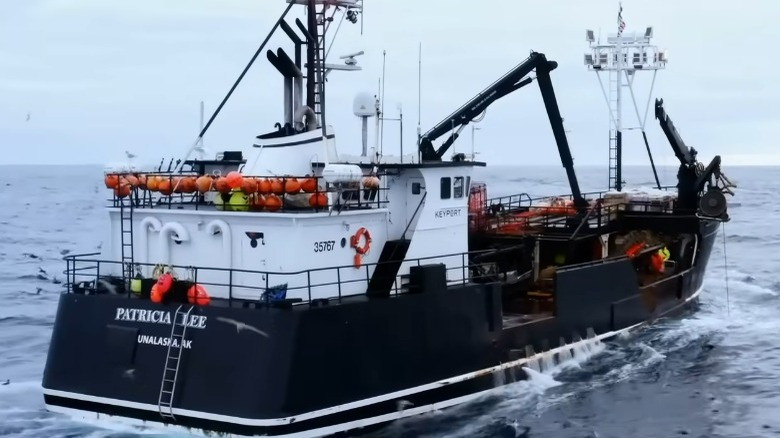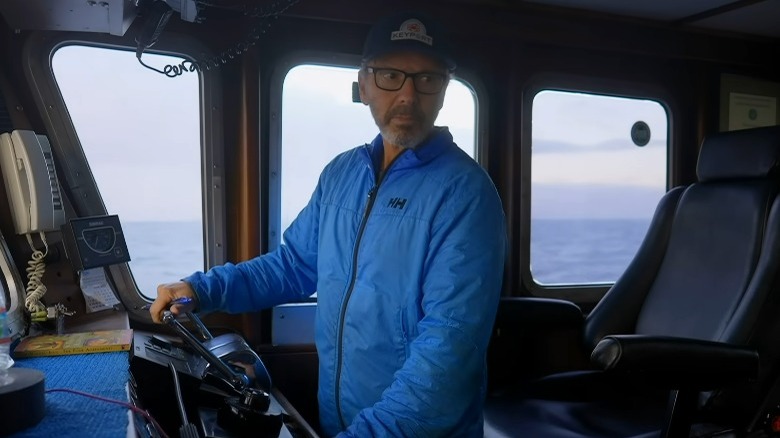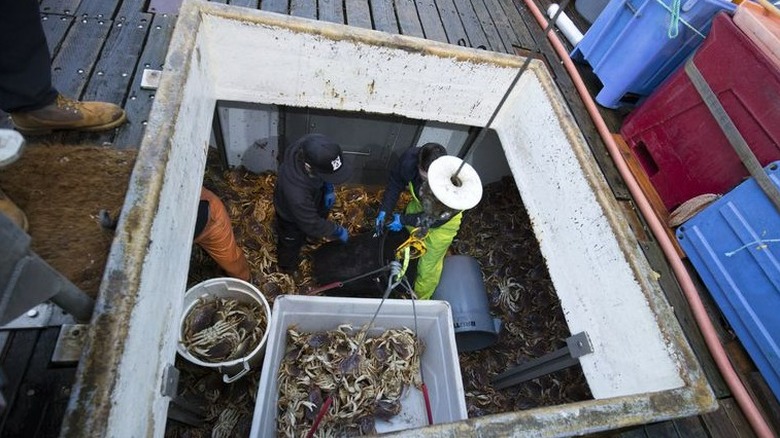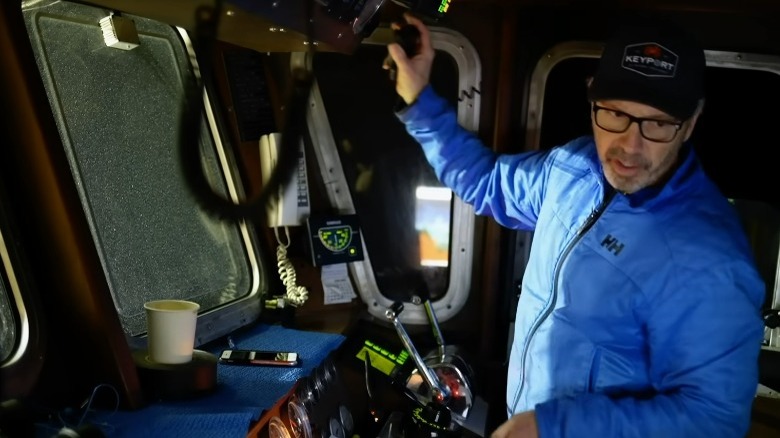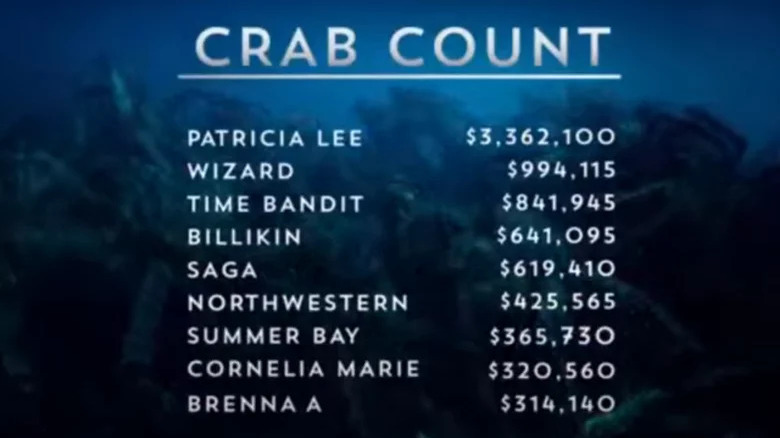Facts About Deadliest Catch Captain Rip Carlton Fans Should Cast Their Nets For
Fans of "Deadliest Catch" may have only met Captain Rip Carlton in the premiere of Season 18, but Carlton has been fishing the Bering Sea since the mid-1970s. Having no experience whatsoever, this thrill seeker traveled from his hometown of Bend, Oregon to Alaska at only 18 years old after hearing about the financial opportunities available. He immediately thrived and made his way up the ladder from a true greenhorn to captain in just ten years.
Carlton denied "Deadliest Catch" producers access to his boat numerous times, claiming that the show would slow down his operation. However, when the Alaskan government shut down the red king crab fishery for the 2021 to 2022 season, the show's 18th Season focused on other fisheries like black cod, Dungeness crab, and Rip Carlton's specialty, the Golden King crab. This — plus a solid nudge from his family — made Carlton finally give in to the cameras.
Fans first heard about Carlton's boat, the Patricia Lee, in Season 17 when "Wild" Bill Wichrowski and his Summer Bay crew heard the news that their former crew member Todd Kochutin was fatally injured on the "Patty Lee." In Carlton's very first episode, we saw him attend a memorial for his fallen crew member before prepping his boat for a golden king crab trip. Fans felt for him and were interested in learning about this new fishery. Having only been featured in one season so far, there's still a lot to learn about the newest "Deadliest Catch" star. Here's the untold truth of Rip Carlton.
He is one of only five captains that harvests Golden King crab
With the Red King crab season closed in the 2021 to 2022 season, Captain Rip Carlton joined the show to show us how Golden King crab fishing is done. As stated in his bio on the Patricia Lee's website, Rip "is the captain of one of only five boats that harvest Golden King Crab," which positions him as "one of the world's foremost authorities on Goldens."
Of the 40 known species of King crabs, there are only three that are commercially fished — the Red King, Blue King, and Golden King crab. Golden Kings are usually found along a volcanic chain off the coast of the Aleutian Islands, so that's mainly where Carlton and the Patricia Lee can be found. Captain Josh Harris of the Cornelia Marie told Entertainment Weekly, "Gold King crabs are a complicated thing to do." Then he explained, "You're setting the pots down 10 times as deep as they normally should be going, and that's a lot of work. There was a lot of danger involved with hauling that much line, and it takes a long time and really takes a toll on the guys, too."
The Golden King crab is the deepest commercial fishing in Alaska, found at depths of 1800 feet. Thankfully, Carlton's boat has the equipment needed to regularly fish for them, while Red King fishing boats have to improvise.
He only took up crab fishing to fund his professional car racing ambitions
As an 18-year-old from Bend, Oregon, Carlton originally had his sights set on Europe. Having heard more about the fast cash element of crab fishing than the life-threatening element, he ventured to Alaska as a means of embarking on a racing career. In an interview with OPB, he said, "I just went up to try to earn some money to go race cars in Europe like every 18-year old, I mean why not?" Only after the completely inexperienced Carlton arrived in Alaska did he realize the very real opportunities.
Carlton described his introduction to the industry by explaining, "And I asked the guys about fishing and they go, oh yeah we can make a lot of money. And I'm like, oh yeah, really? They go yeah, but it's really hard and it's really dangerous and the light went off in my head and I said, oh that sounds perfect."
Whether it was race car driving or crab fishing, it seems like Carlton has always been interested in an adrenaline rush. Fans saw him get pretty amped up while a Coast Guard swimmer landed on his deck for the medevac of Francis Katungin. Following up on his racing ambitions, Carlton told OPB, "I bought a nice Porsche and I drove that for a couple of years and then I did buy race cars and I raced up and down the West Coast for about eight years trying to become a professional driver and never quite got there. But I gave it a good effort."
He once lived in a tent in an abandoned military barracks
We've all heard some solid "roughing it" stories, but this one might be the roughest — and maybe the most original. Not only did Rip Carlton have zero experience fishing, but when he arrived in Alaska, he had zero contacts for possible work and no place to sleep. In pure vagabond style, while looking for work around the harbor, Carlton pitched a tent inside an abandoned barracks on the beach (via The Bulletin). Not South Beach in Miami, Florida, mind you — a Bering Sea beach. Don't worry, when the weather got rougher than usual, he would block the wind by hammering plastic over a window with a rock and rusty nails and burn things in a 55-gallon drum for heat.
In an interview with his hometown newspaper, Carlton recalls, "I had a backpack, a sleeping bag, a loaf of bread, and peanut butter and jelly. Because there were no restaurants. There was nowhere to stay up there at the time, and I lived on the beach for four weeks, in an abandoned barracks from World War II." Thankfully, this rags-to-riches story is now complete as he now pulls in multi-million dollar quotas annually as captain and co-owner of the Patricia Lee.
Rip's crew suffered two life-threatening injuries and a fatality in only eight months
At only 30 years old, deckhand Todd Kochutin passed away on February 26, 2021, from injuries that occurred on Carlton's boat, the Patrica Lee. "Deadliest Catch" cameras rolled as news of an unknown fisherman's injury spread throughout the fleet. Knowing that former crew member Todd was on that boat, "Wild" Bill Wichrowski tells Todd's friend, "Hey Landen, Patty Lee's got a medevac, but we don't know who it is. But, I don't know ... Hopefully it's not Todd." A crew mate does some digging and informs Bill (and the viewers at home) that it was Todd and that he passed away.
Carlton tells OPB, "You can't put into words what's going through your brain; you can't comprehend it. And Todd was one of my favorite guys. He worked with us for a while, five years, he was part of our family."
The following season, now aboard the Patricia Lee, deckhand Francis Katungin was crushed by a pot in the same manner as Todd. As the crew puts him on a stretcher and carries him off the deck, Rip says, "Deja vu all over again." He steams to get in range of the Coast Guard helicopter and Katungin is rescued.
Katungin was replaced on deck by Devon Davis, and before Davis' first trip, Carlton declares, "This is our redemption trip." and warns, "Devon it's your first time on the boat. Don't get hurt." Not long after, Devon is hit in the head by something, drops to the deck unconscious, and spits up blood. This becomes the third injury to occur on the Patricia Lee in just eight months (via Yahoo!).
His son convinced him to be on Deadliest Catch
Captain Rip Cartlon was adamantly opposed to being featured on "Deadliest Catch," but not because he wasn't a fan. Throughout the show's run, his son Derek loved the show, and Carlton legitimately enjoyed watching it with him. Carlton even praised the show for doing a great job in portraying the reality and difficulty of catching crab, as well as helping get his son so interested in his profession that he actually went out fishing with him (via OPB).
Carlton's hesitation stemmed from witnessing the "Deadliest Catch" boats finish fishing trips early because they were obligated to the show's filming schedule. Rip was too busy for that nonsense. He explained to OPB, "We have a lot of crab to catch, like a lot. We don't have time to do much screwing around. That's what we would call it when they had all the boats that were on the show would have to be in town at a certain time and we're just in and out of town cranking out trips."
Executive producer Arom Starr was relentless in his hunt for Captain Rip. After multiple attempts, Rip explained his reservations, and Starr assured him that he would not be beholden to the same filming schedule as the other boats. This began to wear Carlton down, but he credits his son's pleading as the final straw. Opting for the flattery route, Derek told his father, "Dad, you're so much a better fisherman than those guys. And you are so funny ... And then he goes, and dad, in 20 years when you're gone, I'll be able to stick that little memory stick in the computer and show my kids and go, that's my dad." Rip said, "And that was the kicker. I went, all right, I get it, I'll do it."
Carlton had a brush with death and just kept fishing
Close calls on the Bering Sea are inevitable — it's the reason we're so enamored with "Deadliest Catch" in the first place. Any captain or crew member will probably be able to tell you about the time they thought their number was up, and while most people would find a new line of work, these fishermen keep coming back for more. With more than 45 years of fishing experience, Captain Rip Carlton has knocked on death's door and gotten right back to work. Thanks to his fast reflexes, he lived to tell the tale.
Carlton told The Bulletin, "I was driving a 165-foot boat and the wheel house was three stories up. And we took such a big wave, the wave came through the wheelhouse windows, came through with so much force it was like a bomb blowing up. Then the back door got blown off the door hinges, the whole boat flooded up to the wheel house."
Initially thinking their Captain was dead, the crew rushed up from the breakfast table and saw their captain miraculously unharmed. He continued, "But I ducked, I saw the wave coming and I ducked down and it went right over my head through the windows and out the back windows and out the back door." That duck saved him from being completely washed out of the boat. His crew rushed to set up plexiglass storm windows, and Carlton picked up his emergency radio. A concerned voice on the other end asked if they needed anything — Carlton asked for more bait.
He is extremely ambitious
With fishing experience that predates Keith Colburn, "Wild" Bill Wichrowski, and even Sig Hansen, Rip Carlton is one of the longest-tenured commercial fishermen in the fleet. After moving to Alaska in the mid-1970s, Carlton started from the bottom, and never stopped hunting for more. He first worked in a factory while hunting for a job on a boat, and before going out on a fishing trip, his first job in the commercial fishing industry was on the dock, unloading shrimp (via The Bulletin). Factory work and dock work didn't last too long as he sidled up to Norwegian crab fisherman, and was given a job on a boat in only four months.
"I wanted to impress them with my work ethic and I did and they told me they heard a job might be opening up on another boat. So I went over and I got hired about 6:00 AM when the guys woke up with a hangover and nobody wanted to go fishing and I was standing there," Carlton told OPB.
Most deckhands are just happy to land the gig, but this was just the foot in the door for Carlton. He comically describes his rise from greenhorn to owner and operator in an interview with his processor and distributor, Keyport LLC. "When I was down on deck, filling bait cans for the first time, I looked at the guy running the hydraulics — the Chief — I go, 'that's the job you want.' Then, wait a second, I looked up at the guy running the boat, and I said, 'Naw, that's the job you want.' Then I got down to the shipyard, and I saw the owner just kind of show up once in a while and I went, 'Oh wait a minute ... That's the guy!' So I've done the whole thing." At this rate, he'll be running his own fleet in no time!
Fans criticized Discovery Channel's decision to feature Rip Carlton
"Deadliest Catch" began as a pure documentary of the profession of crab fishing. Considering that the very first season saw the sinking of the Big Valley, claiming the lives of five out of six crew members, there was no need to amp up the drama. Fans were hooked, but as seasons have progressed, the show has had to find new ways to keep them tuning in since — thankfully — tragedies like the Big Valley do not happen every season. They began focusing on interpersonal dramas and life events like Clark Pederson proposing to Sig Hansen's daughter Mandy on camera.
However, the death of Todd Kochutin aboard the Patricia Lee was a shocking real-world tragedy. In the aftermath, some fans took issue with the timing of Carlton's "Deadliest Catch" debut because Kochutin's tragic passing was in Season 17, and the boat he died on was featured for the first time in Season 18. The first time fans saw Carlton was at Kochutin's memorial, and some felt the decision was to dramatize his passing for all it was worth. Outsider gathered Reddit posts with some calling the decision "disrespectful to the late star's memory," "the lowest hanging fruit," and accused Discovery of "upping the melodrama." It didn't help that Carlton's first season saw two near-fatal injuries — one of which resulted from the same situation that claimed Todd's life.
Carlton is a top earner, by a long shot
In Rip's first scene at the helm, he tells "Deadliest Catch" cameras, "We have about 1.5 million pounds of quota to catch." Narrator Mike Rowe explains that this is a fleet leading 21 million dollars of quota. Now we understand why he didn't need the distractions that come with filming. Since day one, the show has always kept fans abreast of each boat's earnings with a Crab Count leaderboard, and deeper into Season 18, we see just how much more Carlton pulls in than the other boats. At $3,362,100, the Patricia Lee had earned over three times more than the second-place Wizard and ten times more than both the Cornelia Marie and the Brenna A.
The Patricia Lee's "long lining" fishing style is a major factor in its dominance. On top of Carlton's experience in Golden King crab fishing, his boat discharges up to 50 pots at one time, while most other boats only drop one at a time. When pulling up this string, the pots come up every 90 seconds. He told OPB, "We pull so much more gear than anybody else out in Alaska. We literally pulled 10 times as many pots as anyone. So the longer you do something, the odds of something happening increase."
